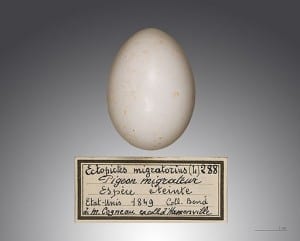by Ben Novak Birds are a huge challenge for de-extinction for two big reasons. The first is because less genomic research has been performed on birds than on mammals (but reptiles, amphibians, fish, invertebrates and plants are even less understood). We don’t know how the majority of gene pathways in birds work on the cellular levels and up.
But this is far less challenging to de-extinction than the inability to clone a bird. The reason that the absence of a uterus is a problem for cloning relates to how cloning is done. When you take the nucleus out of an egg cell you kill that cell, it is completely dead. Even after you put a new nucleus in it, the cell is still dead. You have to bring the cell back to life, just like when you shock someone’s heart into beating again. You run electricity through the newly cloned cell to get it to divide. The problem here is that you have to keep stimulating cell division for many generations, up to several hundred and even a few thousand cells before the embryo will develop on its own without assistance. Therefore you cannot take a single cloned cell and implant it into an ovary, oviduct, uterus or any reproductive organ and get it to grow – you have to grow it in the lab and then implant a partially developed embryo. This is okay in a uterus because the embryo implants and develops in a fixed place. In a bird, the embryo is in constant motion within the female’s body – literally tumbling down the oviduct as the oviduct coats the eggshell around the embryo. To implant a cloned embryo one would have to take out the developing embryo from within a developing hard shelled egg within the female’s body and replace it with the cloned embryo – and hope that the embryo integrates into the yolk of the egg and that all the puncturing doesn’t deform the egg or harm the female. So you can see it’s very very tricky. By the time the egg actually exits the female’s body the embryo inside it is 50-60,000 cells and already developing tissue types that are integrated into the yolk and amniotic membranes surrounding it. It is not likely to be able to grow a cloned embryo to such an extensive developmental stage. If you could grow an embryo to that point, it may not be viable to remove the egg’s endogenous embryo and “swap” in the cloned embryo, because of how integrated the embryo quickly becomes to the yolk and amniotic tissues.
Are there ways to introduce an extinct bird’s genetics into an embryo without cloning? You can introduce cells into the embryo, which will integrate and create a chimeric bird – a bird that has a patchwork of tissues made of cells of both the original embryo and the cells that were introduced. This can be done after the egg is laid, avoiding tampering with the mother’s internal organ systems. The problem for de-extinction is that adult stem cells (or induced Pluripotent Stem cells, iPCs) cannot contribute to the germ line, only Embryonic stem cells can contribute to the germ line. We can’t easily use embryonic stem cells to recreate the passenger pigeon genome. After as few as seven days in a lab culture, embryonic stem cells have undergone enough cell division to be adult stem cells, and lose the ability to become germ cells. A process to use embryonic stem cells would require introducing a mutation to a band-tailed pigeon embryonic stem cell in less than a matter of a few days, then put it into an embryo and hatch a chimera. This would then require hundreds to even thousands of generations of chimeric birds until we have a passenger pigeon. It would be far more efficient to introduce the thousands of mutations in cell lines, then create a bird. But by the time all the mutations were added, the cells would be adult stem cells. You could make as many chimeras as you want from these “de-extinct” stem cells, but they would never form a breeding line. This does not mean that stem cells cannot become germ cells under experimental conditions, what this means is that they do not naturally become germ cells when placed inside a developing bird embryo. It may be possible in the future to program iPSCs to become germ cells, but currently this is not possible. In order to get the germ cells of the chimera to be from our de-extinct bird, we need to use germ cells themselves.
Using pure germ cells to create a chimera works, effectively replacing the original embryo’s germ line with the new inserted germ line. Germ cells can be kept in culture for many generations without losing their potency (allowing us to make the genetic changes to make a “de-extinct” genome). Germ cells can and have been transferred from one species to another – chicken to quail, chicken to guinea fowl, chicken to duck, houbara to chicken, and pheasant to chicken to name a few examples. Most of this work has been conducted by isolating germ cells from a donor individual and immediately transferring them to the recipient embryo because culturing germ cells long term is difficult. To induce genetic changes, the germ cells need to be cultured. At present, germ cells have only been successfully cultured for chicken and houbara, but projects for culturing more species germ lines are underway. It could be possible to program stem cells to become germ cells for germline transfer of this nature. Stem cells (iPSCs) were successfully developed into sperm and eggs for mice. To this date stem cells have not been stimulated to develop into germ cells in birds. These are among the challenges to overcome to go from a resurrected genome within a cell line to making a breeding bird. The projects we need to start to revive the passenger pigeon are primarily the development of culture methods to isolate and propagate band-tailed pigeon primordial germ cells, as well as the ability to use iPSCs to develop germ cells as an alternate pathway. With successful development of these project pathways, the germ cells of band-tailed pigeons will be used to engineer the passenger pigeon genome: creating germ cells carrying the passenger pigeon genetic code, effectively “new passenger pigeon germ cells”. These germ cells can then be transferred to band-tailed pigeons, or the more prolific rock pigeon, to generate germline chimeras that can breed and reproduce passenger pigeons.




